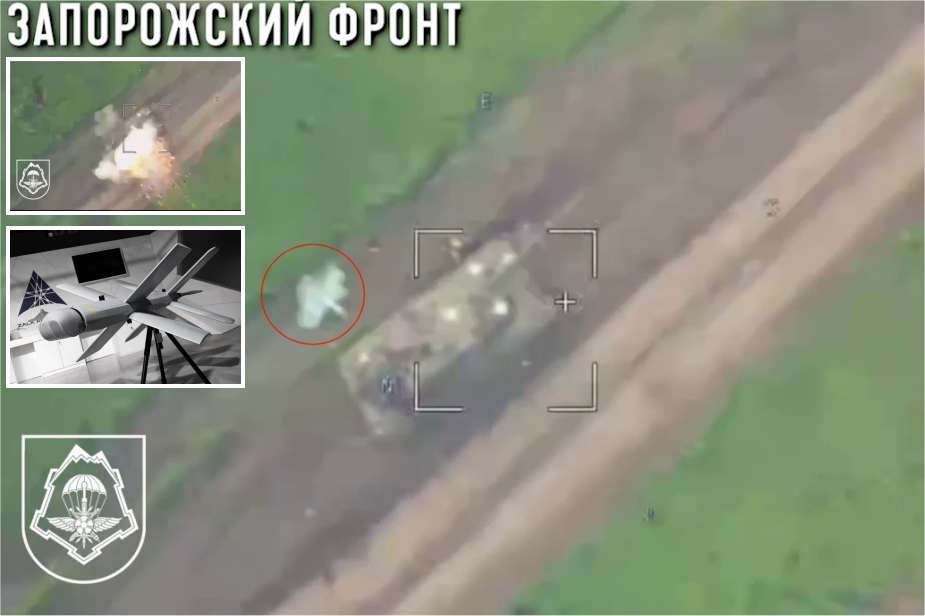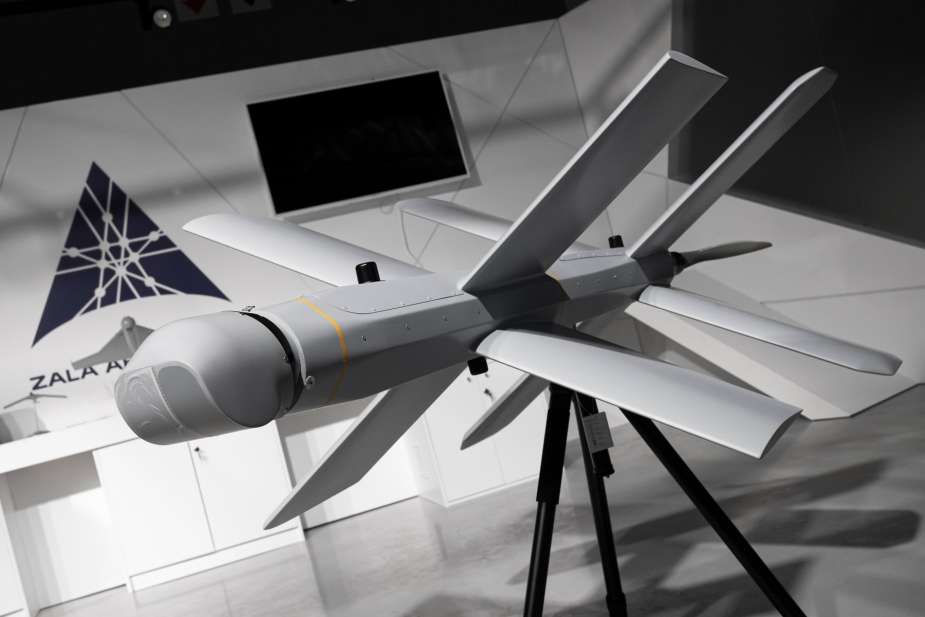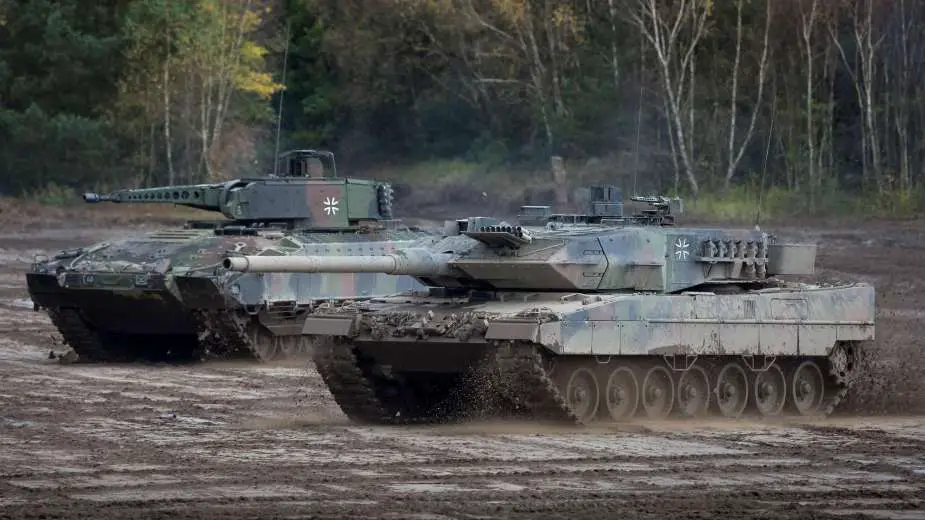First Ukrainian Leopard 2A6 tank hit by Russian Lancet drone
On August 3, 2023, a video was published on Telegram showing for the first time a Ukrainian Leopard 2A6 tank hit by a Russian Lancet drone. This shows once again that the Russian army is intensifying the use of Lancet drones to primarily target modern equipment provided by European countries and allies of Ukraine.
Follow Army Recognition on Google News at this link

First recorded hit of a Ukrainian Leopard 2A6 by a Russian Lancet drone (Picture source Telegram)
Western tanks, particularly models like the Leopard 2 variants, hold significant importance for Ukraine in its defense against invading Russian forces. These tanks are perceived to have advantages over the majority of Russian tanks in terms of sight capabilities, firepower, protection, and stabilization, providing Ukrainian forces with a clear advantage on the battlefield.
The increasing use of Lancet drones by Russian troops in Ukraine can be attributed to several key factors. First and foremost, the cost-effectiveness of these UAVs makes them an appealing choice compared to traditional military hardware like missiles or tanks, which can be considerably more expensive. With a relatively affordable cost of around $35,000, the Lancet drones offer a cost-efficient solution for the Russian military's operational requirements.
Additionally, Russian President Vladimir Putin's statement that foreign-made tanks are a priority target for Russian forces in Ukraine suggests that tanks now in the possession of Ukrainian forces are of particular concern to Russia during the ongoing conflict. The historical comparison with the German Tiger tank from World War II, known for its superiority, adds to the perceived threat of the Leopard 2A6.
Moreover, the versatility of the Lancet drone, serving both reconnaissance and strike missions, makes it a valuable asset on the battlefield. Its capability to conduct targeted strikes against group objectives enhances its effectiveness in various military operations.

Russian ZALA Lancet drone (Picture source Yandex)
The latest-generation Lancet variant, the Izdelie-53, has further contributed to its increasing deployment. With a new tube launcher accommodating up to four Lancet drones and an intelligent communication system, enabling autonomous target selection and coordinated strikes, the Izdelie-53 exemplifies a significant advancement in drone warfare capabilities. Due to the escalating conflict in Ukraine, Russia has tripled the production of Lancet drones to meet military demands on the frontlines.
Developed by the Russian company ZALA Aero Group, the Lancet, officially designated as Item 52/Item 51, stands as a cutting-edge UAV and loitering munition. Unveiled at the ARMY-2019 military expo in Moscow, this aerial weapon serves dual purposes of reconnaissance and strike missions. Equipped with optical-electronic guidance and a TV guidance unit, the Lancet boasts exceptional control during the terminal stage of its flight. Furthermore, it incorporates intelligence, navigation, and communications modules, empowering it with enhanced operational capabilities.
An intriguing feature of the Lancet drone is its "air mining" role, enabling the UAV to perform high-speed dives of up to 300 kilometers per hour, effectively engaging and neutralizing enemy unmanned combat aerial vehicles (UCAVs) mid-flight. With a maximum range of 40 kilometers and a maximum takeoff weight of 12 kilograms, this drone has become a valuable asset for the Russian military, capable of launching high-explosive or HE-fragmentation warheads with precision.

Germans Leopard 2A6 MBT and a Puma IFV during a demonstration exercise in Munster (Picture source Bundeswehr)
Russian soldiers target the Leopard 2A6 for several reasons. The tank's reputation as one of the world's best, known for its advanced mobility, protection, and firepower, draws their attention and concern. Its primary armament, the high-velocity 120mm smoothbore gun, is capable of firing armor-piercing and high-explosive rounds with exceptional penetration capabilities, believed to be able to penetrate the frontal armor of Russian tanks like the T-72 and T-62, even at significant ranges. This makes this tank a priority target for Russian soldiers since the supply of 18 Leopard 2A6 to Ukraine by Germany in March 2023
Additionally, the Leopard 2A6's advanced armor protection, featuring a composite armor of ceramic and steel materials, poses a challenge for Russian forces. They are aware that this tank can effectively defend against various munitions, including anti-tank missiles and kinetic energy penetrators, setting it apart from their own tanks, such as the T-72, which rely on less effective steel armor.
The Leopard 2A6's optics, fire control systems, and highly efficient four-member crew make it a formidable opponent on the battlefield. Russian soldiers acknowledge that the tank's combat effectiveness and survivability are enhanced by its ability to perform quick maneuvers, reducing its vulnerability to counterattacks.
However, Russian forces also recognize some potential vulnerabilities in the Leopard 2A6. Notably, the tank lacks Explosive Reactive Armor (ERA), leaving it potentially more susceptible to shaped charge and high-explosive anti-tank (HEAT) projectiles commonly used in modern anti-tank weapons, such as the Lancet. Additionally, the absence of active protection systems (APS) means that certain incoming threats may pose a challenge to the tank's defenses.
The active protection system (APS) is a technology designed to detect and intercept incoming threats, such as anti-tank missiles and rockets before they can strike the tank. These systems use sensors, radars, and countermeasures to provide an additional layer of defense against various anti-tank munitions.
In modern warfare, where anti-tank-guided missiles (ATGMs) and other advanced weapons pose significant threats to armored vehicles, APS has become increasingly crucial for tank survivability on the battlefield. By neutralizing or redirecting incoming projectiles, APS can greatly enhance a tank's chances of avoiding critical hits and maintaining operational readiness.























